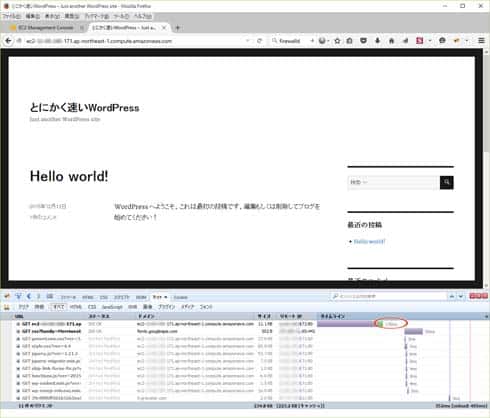Measure page load time
Next, you will measure the page load time. You can use the Firefox addon Firebug or other development tool to see the load time. Refresh and note the time. In my example, the time was 176ms.

Return to the terminal and use the ab command to perform a benchmark test. Enter the following to test your front page using 100 requests and 10 concurrent requests.
[root@ip www]# ab -n 100 -c 10 http://ec2-xxx.xxx.compute.amazonaws.com/
The following result data will appear:
This is ApacheBench, Version 2.3 <$Revision: 1430300 $> Copyright 1996 Adam Twiss, Zeus Technology Ltd, http://www.zeustech.net/ Licensed to The Apache Software Foundation, http://www.apache.org/ Benchmarking ec2-xxx.xxx.compute.amazonaws.com (be patient).....done Server Software: Apache/2.4.6 Server Hostname: ec2-xxx.xxx.compute.amazonaws.com Server Port: 80 Document Path: /Document Length: 11373 bytes Concurrency Level: 10 Time taken for tests: 8.894 seconds Complete requests: 100 Failed requests: 0 Write errors: 0 Total transferred: 1166200 bytes HTML transferred: 1137300 bytes Requests per second: 11.24 [#/sec] (mean) Time per request: 889.361 [ms] (mean) Time per request: 88.936 [ms] (mean, across all concurrent requests) Transfer rate: 128.05 [Kbytes/sec] received Connection Times (ms) min mean[+/-sd] median max Connect: 0 0 0.1 0 0 Processing: 449 876 70.2 879 1004 Waiting: 437 842 67.2 849 974 Total: 449 876 70.2 879 1004 Percentage of the requests served within a certain time (ms) 50% 879 66% 909 75% 920 80% 930 90% 951 95% 976 98% 991 99% 1004 100% 1004 (longest request)
Requests per second is how many concurrent requests were processed in one second. In my case it was 11.24.
You can estimate this amount. Since the instance uses a dual-core CPU, if you divide 1000ms by 176ms and multiply by 2 you will get 11.36, very close to 11.24. As you can see, page load time and requests per second are inversely related.
